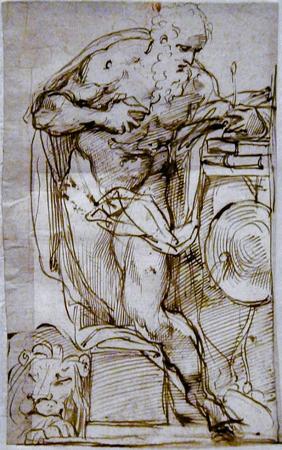Agostino Carracci (1557 - 1602). Agostino Carracci was an Italian painter, printmaker, and draughtsman who, along with his cousins Annibale and Ludovico Carracci, founded the influential Bolognese School of painting. He is known for his contributions to the development of Baroque art, and his works encompass a wide range of subjects, including religious, mythological, and genre scenes. He painted The Last Communion of St. Jerome, now in the Church of San Girolamo della Carità in Bologna. This large-scale altarpiece is considered one of his masterpieces. The painting depicts the dying St. Jerome receiving his last communion, surrounded by mourning figures and set against a dark, atmospheric background. The work is notable for its dramatic use of light and shadow, as well as its emotional intensity, which would become hallmarks of the Baroque style. He also painted The Lamentation over the Dead Christ in the Pinacoteca Nazionale, Bologna. This painting depicts the moment when the body of Christ is being prepared for burial, with the Virgin Mary, St. John the Evangelist, and other figures gathered around him in a poignant scene of grief and devotion. Agostino Carracci was born in Bologna as the son of a tailor. he was the elder brother of Annibale Carracci and the cousin of Ludovico Carracci. He initially trained as a goldsmith. He later studied painting, first with Prospero Fontana, who had been Lodovico's master, and later with Bartolomeo Passarotti. He traveled to Parma to study the works of Correggio. Accompanied by his brother Annibale, he spent a long time in Venice, where he trained as an engraver under the renowned Cornelis Cort. Starting from 1574 he worked as a reproductive engraver, copying works of 16th century masters such as Federico Barocci, Tintoretto, Antonio Campi, Veronese and Correggio. He also produced some original prints, including two etchings. He traveled to Venice and Parma. Together with Annibale and Ludovico he worked in Bologna on the fresco cycles in Palazzo Fava and Palazzo Magnani. In 1592 he also painted the Communion of St. Jerome, now in the Pinacoteca di Bologna and considered his masterwork. In 1620, Giovanni Lanfranco, a pupil of the Carracci, famously accused another Carracci student, Domenichino, of plagiarizing this painting. From 1586 is his altarpiece of the Madonna with Child and Saints, in the National Gallery of Parma. In 1598 Carracci joined his brother Annibale in Rome, to collaborate on the decoration of the Gallery in Palazzo Farnese. From 1598-1600 is a triple Portrait, now in Naples, an example of genre painting. In 1600 he was called to Parma by Duke Ranuccio I Farnese to begin the decoration of the Palazzo del Giardino, but he died before it was finished. Agostino's son Antonio Carracci was also a painter, and attempted to compete with his father's Academy. An engraving by Agostino Carraci after the painting Love in the Golden Age by the 16th-century Flemish painter Paolo Fiammingo was the inspiration for Matisse's Le bonheur de vivre.
more...













